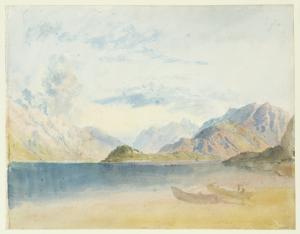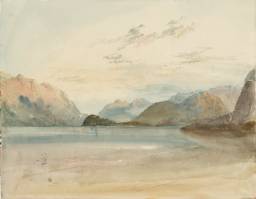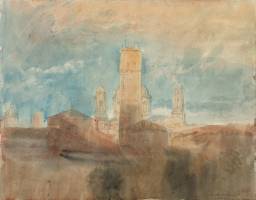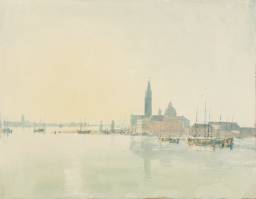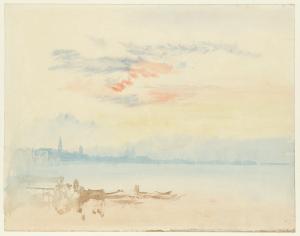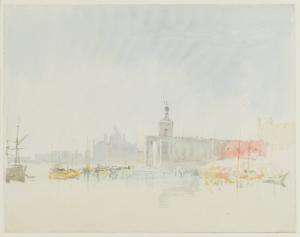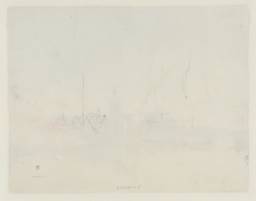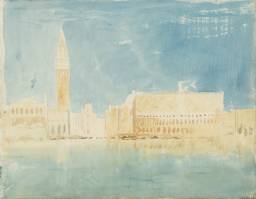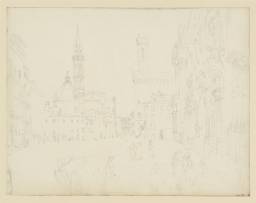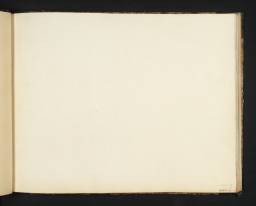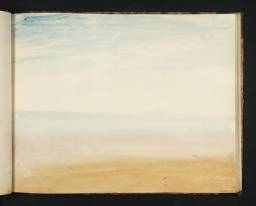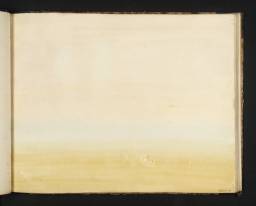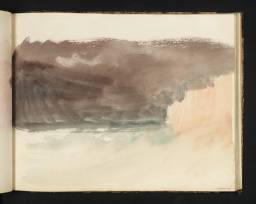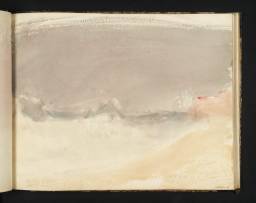Turner Bequest CLXXXI 1–44
Sketchbook, bound in boards, covered in off-white paper mottled in black, teal and brown, half-bound over dark green leather corners and spine with seven gold-tooled single bands; remains of two anchoring points for securing ribbons on front cover
44 leaves (the first eight now mounted and substituted with similar modern paper) and pastedowns of white wove paper, with ?modern front and rear free endpapers, average page size 225 x 290 mm; watermark ‘J Whatman | 1816’
Made by William Balston of Springfield Mill, Maidstone, Kent
Inscribed by Turner in ink ‘67 Como’ on a label on the spine (now lost)
Stamped in black ‘CLXXXI’ on front cover, top right
Blind-stamped with Turner Bequest monogram inside front cover, towards top left
Numbered 230 as part of the Turner Schedule in 1854 and endorsed by the Executors of the Turner Bequest, inside front cover (see main catalogue text)
Inscribed in pencil ‘CLXXXI’ inside front cover, top centre
Stamped in black ‘CLXXXI’ inside front cover, top left
Inscribed by Arthur Magyar Hind in pencil ‘Rebound 1935 in old cover | Leaves 1 – 8 mounted | AMH’ inside front over, towards top left, and ‘Blank leaves 14 – 44 might be used if required for mending damaged Turner drawings | AMH’ across centre (faint and ?partially erased)
Inscribed in pencil ‘Wt mk 1816.’ inside front cover, bottom centre
Inscribed in pencil ‘2’ on verso of rear flyleaf, bottom right
Inscribed in pencil ’66.104’ inside back cover, bottom right
44 leaves (the first eight now mounted and substituted with similar modern paper) and pastedowns of white wove paper, with ?modern front and rear free endpapers, average page size 225 x 290 mm; watermark ‘J Whatman | 1816’
Made by William Balston of Springfield Mill, Maidstone, Kent
Inscribed by Turner in ink ‘67 Como’ on a label on the spine (now lost)
Stamped in black ‘CLXXXI’ on front cover, top right
Blind-stamped with Turner Bequest monogram inside front cover, towards top left
Numbered 230 as part of the Turner Schedule in 1854 and endorsed by the Executors of the Turner Bequest, inside front cover (see main catalogue text)
Inscribed in pencil ‘CLXXXI’ inside front cover, top centre
Stamped in black ‘CLXXXI’ inside front cover, top left
Inscribed by Arthur Magyar Hind in pencil ‘Rebound 1935 in old cover | Leaves 1 – 8 mounted | AMH’ inside front over, towards top left, and ‘Blank leaves 14 – 44 might be used if required for mending damaged Turner drawings | AMH’ across centre (faint and ?partially erased)
Inscribed in pencil ‘Wt mk 1816.’ inside front cover, bottom centre
Inscribed in pencil ‘2’ on verso of rear flyleaf, bottom right
Inscribed in pencil ’66.104’ inside back cover, bottom right
Accepted by the nation as part of the Turner Bequest 1856
Exhibition history
References
As originally constituted, this substantial sketchbook, now largely blank, included Italian subjects on its first eight rectos. Their documented order conforms to the sequence of Turner’s first Italian tour (1819–20) established by the subjects he recorded in pencil alone in numerous smaller sketchbooks, as discussed by Nicola Moorby in her overall Introduction to the tour.
All in watercolour except one, the first eight leaves were mounted separately in 1935 and replaced with blanks (see the technical notes below). The first were two variations of a view over Lake Como (D15251–D15252; Turner Bequest CLXXXI 1, 2), followed by a rooftop study from a Milan hotel (D15253; CLXXXI 3). Four Venice views followed, showing scenes around the entrance to the Grand Canal and the adjacent Bacino1 (D15254–D15256, D15258; CLXXXI 4–7), with a slight pencil study of boats on the verso of the third (D15257; CLXXXI 6a); lastly came a detailed pencil drawing of a Florence street scene (D15259; CLXXXI 8). Of the seven watercolours, only D15253 and D15258 were made over pencil outlines.
Apart from a very slight study of buildings in pencil on folio 43 verso (D40722), near the back of the book, only four ‘colour beginnings’ now remain in the sketchbook, on the rectos of folios 10–13 (D15261–D15264). All appear to show coastal scenes, the first two being very broadly but delicately brushed in with parallel bands of colour suggesting sky, sea and shore in calm conditions, while the second pair show rougher conditions off a beach and cliffs. In his 1909 Inventory, Finberg applied the same title to each: ‘Commencement of a water colour drawing’;2 for a discussion of the function of such works in general, see the Introduction to the ‘England and Wales Colour Studies c.1825–39’ section.3
Apparently correctly, Finberg regarded the four Venice subjects here as ‘the only colour sketches Turner made during his first visit’,4 complementing the many detailed pencil drawings in the Milan to Venice and Venice to Ancona sketchbooks (Tate; Turner Bequest CLXXV, CLXXVI). He was ‘quite sure’ that the first three (D15254–D15256) ‘were done from memory’, while D15258 ‘may have been painted directly from nature’.5 The extent to which Turner worked directly in colour from direct observation remains a moot point; see the individual entries for further comment. Those tending to think that he did so in Venice include Luke Herrmann, Andrew Wilton and Michael Lloyd,6 although the artist’s reported comment later on the same tour, that ‘it would take up too much time to colour in the open air – he could make 15 or 16 pencil sketches to one coloured’, is often quoted.7 Of the renderings of San Giorgio Maggiore and the Dogana from the same viewpoint (D15254, D15256), Lindsay Stainton has observed:
The fall of the light shows that they were also executed in rapid succession, in the early morning. So closely does the treatment of light accord with the buildings when they are seen from this viewpoint that it is difficult to believe that either watercolour could have been executed except from nature.8
Ian Warrell has concurred that it is ‘evident that some or all of these were painted directly in front of the motif’, in particular the two mentioned above.9 By contrast, Stainton has seen the dawn view in D15255 as perhaps ‘an imaginary view, in which a sunrise or sunset over the Lagoon is recreated and combined with an impression of the silhouette of Venice seen on arrival or departure’ (albeit related to a pencil drawing, as discussed in the work’s individual entry), while the ‘more abstract and less descriptive’ late morning colour over a pencil outline made from the Bacino (D15258) ‘could be a later addition’; nevertheless, while finding it ‘tempting to think that [D15254, D15256 and D15257] represent, in that order, some two hours work between 9 and 11 during a single morning’,10 she has concluded that the ‘uncertainty’ of the four works’ creation is ‘tantalising’.11
Whatever their immediate circumstances and technical means, many Turner scholars and others writing more generally on the artist have tended to regard the four Venice watercolours as exceptional.12 For example, Edward Croft-Murray called them ‘exquisite’, seeing them as ‘anticipating the wonderful colo[u]r impressions of twenty years later, which shows how immediately sensitive he was to the delicate Adriatic light’.13 Gerald Wilkinson felt ‘we can reasonably regard these as the peak’ of Turner’s 1819 Italian watercolour studies,14 and Stainton has characterised them as ‘by far the most remarkable product of Turner’s visit to Venice in 1819’,15 with their ‘freshness and spontaneity’ as ‘the whiteness of the paper glows through the most delicate of translucent washes’;16 John Gage noted their ‘extraordinary limpid quality’.17
Whatever their immediate circumstances and technical means, many Turner scholars and others writing more generally on the artist have tended to regard the four Venice watercolours as exceptional.12 For example, Edward Croft-Murray called them ‘exquisite’, seeing them as ‘anticipating the wonderful colo[u]r impressions of twenty years later, which shows how immediately sensitive he was to the delicate Adriatic light’.13 Gerald Wilkinson felt ‘we can reasonably regard these as the peak’ of Turner’s 1819 Italian watercolour studies,14 and Stainton has characterised them as ‘by far the most remarkable product of Turner’s visit to Venice in 1819’,15 with their ‘freshness and spontaneity’ as ‘the whiteness of the paper glows through the most delicate of translucent washes’;16 John Gage noted their ‘extraordinary limpid quality’.17
Martin Butlin recognised that although the ‘seeds of this revolution lay in much earlier works’,18 it had taken ‘the vision of the Venetian lagoon under the morning sun to fuse ... simpler tonality and depiction of atmosphere’,19 and Herrmann called them ‘far in advance in technique and confidence of the other watercolours that Turner executed on his Italian tour, which are close to those he made of the Rhine and of English subjects in the years just before this’.20 In 1817, Turner had produced fifty or fifty-one Rhine watercolours (various collections),21 on paper prepared with grey wash (see the introduction to the ‘County Durham and Northumberland 1817’ section), and he would make drawings and watercolours of subsequent Italian sites on sketchbook pages toned in a similar way, sometimes scratching through the wash to create highlights (see the Naples: Rome. C. Studies, Rome: Colour Studies and Small Roman Colour Studies books; Tate; Turner Bequest CLXXXVII, CLXXXIX, CXC).
Andrew Wilton has called the Venice subjects ‘startlingly fresh’,22 and evidence that the artist was ‘happy to discard, as it were, all the technical accretions of his career so far, in order to approach a new landscape as innocently as possible’,23 with the ‘sharp yet enraptured vision of the newcomer’24 responding to what the travel writer Jan Morris has evoked as ‘the first impact of Venetian mystery’.25 James Hamilton has described how, in the ‘shock of this first encounter’, Turner for ‘the first time in his watercolour painting ... begins to experiment with hieroglyphic forms, strange superficially abstract shapes in the foreground or middleground which may be gondolas or harbour paraphernalia seen through the haze’.26 Stainton has noted how ‘the buildings are represented with the light either full on them or coming from behind. This causes the architectural details within the contour largely to disappear and the shapes to look almost flat’.27 Warrell has characterised the works as ‘exceptional for the simplicity of means by which the clear light just after dawn is vividly reproduced. There is also an economy in the delineation of form’.28
For all their appeal to the modern (or Modernist) eye and sensibility,29 in 1930 Finberg had considered at length ‘why Turner did not make more than four of them, and why he preferred to devote nearly the whole of his time in Venice to the making of pencil sketches’, qualifying the supposed contemporary assumption that ‘painting is a purely visual art’ by referring to ‘what we call the non-aesthetic elements’ of ‘mind’ and ‘imagination’, and suggesting that it was ‘just these non-aesthetic elements of experience which Turner valued more than – or at least as much as – our visual abstractions’. By comparison with Turner’s later Venetian watercolours (now generally dated to 1840), these are ‘lacking in imaginative fervour, in that atmosphere of poetry and emotion which is distilled, we know not how, from those common experiences which our modern theorists mistrust. They are too purely visual’, and ‘show only what Turner saw with his marvellous eyes; they do not tell us what he thought and felt about Venice’.30
It took time, Finberg concluded, for Turner ‘to overcome the coldness and strangeness of his novel surroundings’ through his many complementary pencil studies, which comprised an ‘act of assimilation’,31 while Wilton has suggested that the 1819 watercolours were ‘for all their exquisite subtlety works without any ulterior motive: it is not surprising, perhaps, that they were not used in the construction of finished works’.32 For an overview of Turner’s work in Venice in 1819 and subsequently, see the Introduction to the Milan to Venice sketchbook (Tate; Turner Bequest CLXXV).
Finberg recorded ‘Turner’s label on back, 67. Como’,33 presumably in ink on paper on the spine of the book, but since lost. David Hill initially suggested that Turner probably added his sequence of numbered and annotated labels during a general review of his sketchbooks in about 1821 or 1822,34 later revising this to the second half of 1824 on the dating evidence of some of the relevant books.35 Ian Warrell has subsequently reasoned that the process began in 1823, ending in the summer of 1824.36
As cited individually, the entries here have been informed by Ian Warrell’s draft notes in Tate catalogue files, complementing his 2003 exhibition catalogue Turner and Venice.
See also Eric Shanes, ‘Beginnings’ in Evelyn Joll, Martin Butlin and Luke Herrmann (eds.), The Oxford Companion to J.M.W. Turner, Oxford 2001, pp.21–3; among many other accounts, see also Andrew Wilton in Martin Butlin, Wilton and John Gage, Turner 1775–1851, exhibition catalogue, Royal Academy, London 1974, p.26; and Andrew Wilton, J.M.W. Turner: His Life and Work, Fribourg 1979, p.187.
See Herrmann 1975, p.231, Wilton 1982, pp.40–1, Lloyd 1996, p.189, Herrmann 2001, p.359; for a contrary view, see Venning 2003, p.156.
For example in Sam Smiles, ‘Open air, work in’ in Joll, Butlin and Herrmann 2001, p.205; see also Gowing 1966, p.19.
Croft-Murray 1963, p.10; for similar comments on the anticipation of later developments, see also Clark and others 1959, p.264, Kitson 1964, p.81, Gaunt and Hamlyn 1981, p.[60], and Stainton 1982, p.20.
Gage 1987, p.49; see also Stainton 1985, p.16, Brown 1990, p.163, Perkins 1990, pp.36, 37, Golding 1996, p.166, Shanes 1997, p.20, Ackroyd 2005, p.97, and Brown 2007, p.14.
Butlin 1962, p.10; see also p.36; see also Rothenstein and Butlin 1964, p.35, and Butlin 1975, p.38.
Herrmann 1975, p.[29]; see also Gaunt 1981, p.11, Wilton 1982, p.40, Powell 1984, pp.43, 68–9, Powell 1987, p.16, Gaunt 1994, p.10, and Brown 2002, p.110.
Wilton 1979, pp.374–9 nos.636–86, mostly reproduced; the disputed work, no.678, is larger and on different paper.
See David Hill, ‘The Landscape of Imagination and the Sense of Place: Turner’s Sketching Practice’ in Maurice Guillaud, Nicholas Alfrey, Andrew Wilton and others, Turner en France, exhibition catalogue, Centre Culturel du Marais, Paris 1981, pp.143, 147 note 34.
See David Hill, Turner on the Thames: River Journeys in the Year 1805, New Haven and London 1993, p.176 note 79.
Technical notes
How to cite
Matthew Imms, ‘Como and Venice Sketchbook 1819’, sketchbook, March 2017, in David Blayney Brown (ed.), J.M.W. Turner: Sketchbooks, Drawings and Watercolours, Tate Research Publication, July 2017, https://www

